Are waterproof boots a must-have for your upcoming adventure in Vietnam? When planning a trip to Vietnam, one of the most frequent questions travelers ask is whether to invest in waterproof footwear. At SIXT.VN, we understand the importance of being prepared for any adventure, and choosing the right footwear is crucial for a comfortable and enjoyable experience. The answer isn’t always straightforward, as it depends on various factors such as the time of year, the regions you plan to visit, and the types of activities you’ll be engaging in. To help you make an informed decision, SIXT.VN will explore the pros and cons of waterproof versus non-waterproof boots, offering insights into waterproofing technology, breathability, performance, and more. Whether you’re planning to trek through the lush rice terraces of Sapa or explore the bustling streets of Hanoi, understanding the nuances of footwear will ensure your feet stay happy and your trip unforgettable. Let’s dive into the details to help you decide if waterproof boots are the right choice for your Vietnam adventure. Stay tuned for practical tips and expert advice that will enhance your travel experience.
1. Understanding Waterproofing Technology in Hiking Boots
Hiking boots and shoes labeled “waterproof” feature a special lining made of a waterproof membrane, often Gore-Tex, placed beneath the outer shell. This membrane is constructed from expanded polytetrafluoroethylene (ePTFE) and is sandwiched between a lining and a knit backer. These three layers are bonded and sewn together to form a sock-like “bootie” inside the upper for a comfortable fit. While Gore-Tex is the most common technology, some brands use their proprietary versions, such as Keen’s Keen.Dry, found in their popular Targhee IV Waterproof boots, which works similarly. For added protection, the upper of waterproof shoes is often made of water-resistant materials or treated with a durable water repellent (DWR) coating. However, DWR coatings wear off over time and require maintenance to restore their effectiveness. Hikers often treat their leather shoes with products like Nikwax to maintain water resistance.
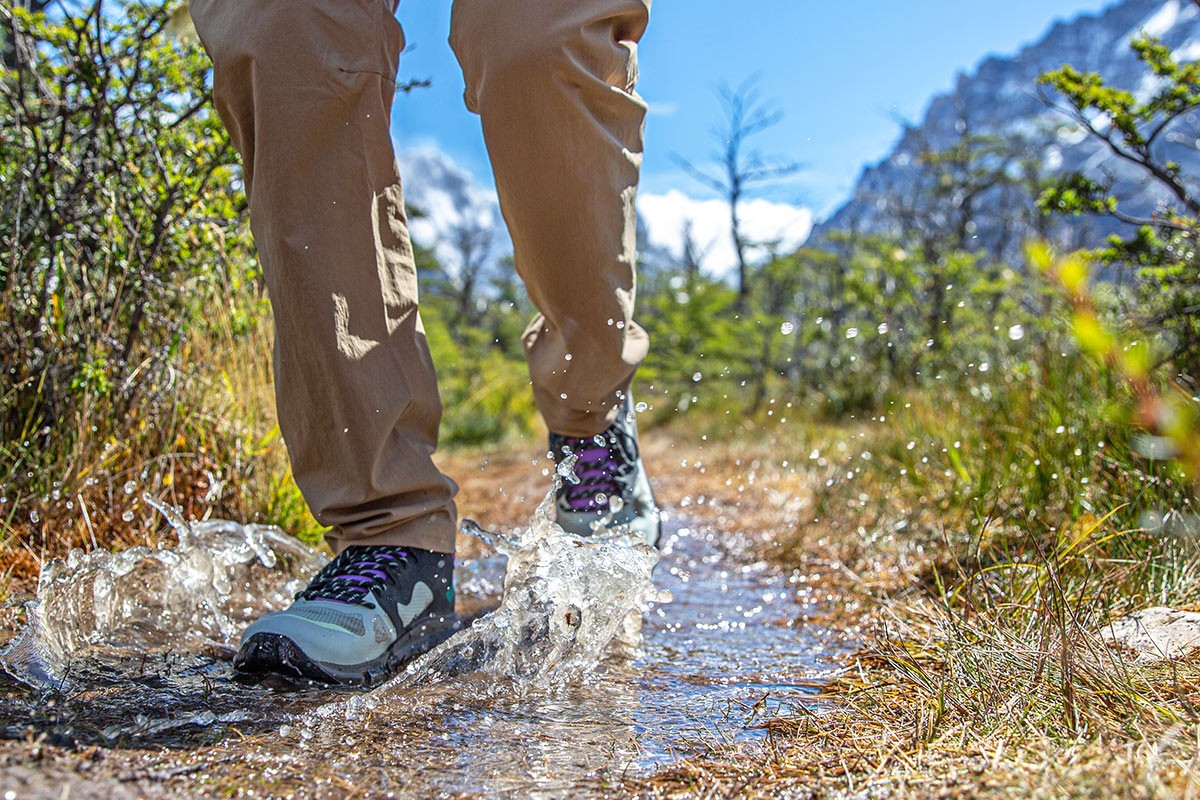 Waterproof hiking boots in shallow water
Waterproof hiking boots in shallow water
2. How Breathability Impacts Your Comfort
Is breathability a key factor to consider when choosing hiking boots? While keeping water out seems logical, it’s crucial to consider the trade-offs. Waterproof shoes don’t breathe as well as non-waterproof options. Non-waterproof boots typically use ventilated uppers and breathable mesh liners, allowing sweat to escape more easily. Imagine wearing a plastic bag while hiking in the rain—it keeps water out but becomes damp and sweaty inside. In warm, humid conditions, your feet can feel the same way. Gore-Tex membranes are designed to allow moisture to escape from the inside, working reasonably well in mild temperatures and adding insulation in the cold. However, waterproof footwear can feel warm in hot weather.
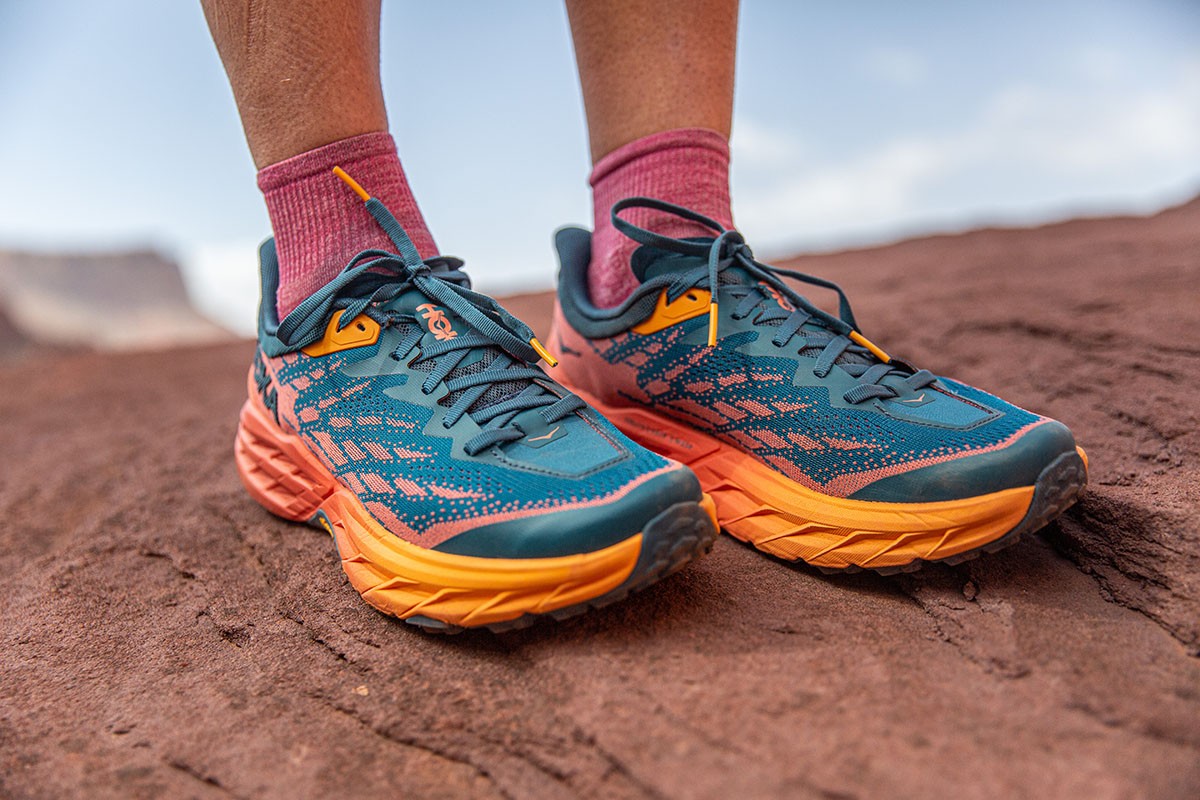 Close-up of Non-waterproof hiking shoes
Close-up of Non-waterproof hiking shoes
3. Weight and Cost Comparison: Waterproof vs. Non-Waterproof Boots
Are waterproof boots significantly heavier and more expensive? A waterproof shoe typically costs more and weighs more than its non-waterproof counterpart. For example, the Gore-Tex version of Salomon’s X Ultra 4 shoe retails for $160 and weighs 1 pound 11.5 ounces per pair, while the non-waterproof model costs $20 less and weighs about 2 ounces less per pair. Similarly, the Oboz Sawtooth X Mid Waterproof boot costs $15 more and weighs 0.4 ounces more than its non-waterproof version. When planning your trip to Vietnam, consider the added weight and cost if you choose to go for waterproof boots.
4. How Effective Are Waterproof Shoes in Reality?
How waterproof are waterproof hiking boots in practice? No hiking shoe or boot is 100% waterproof. Total waterproofness would sacrifice all breathability, like those bright yellow rubber boots you wore as a kid. Hiking footwear balances breathability with waterproofing. Waterproof boots work well for a while, but dirt, sand, and grime can compromise the waterproof membrane, reducing its ability to keep you dry. Consistent cleaning helps, but it’s not always feasible on extended trips. Height matters too; while waterproof liners keep precipitation out, they don’t prevent water from entering over the top during creek crossings. Hiking boots with higher ankles help, but they’re still vulnerable to splashes. According to a study by the Outdoor Industry Association, maintaining your gear properly can extend its lifespan and performance, ensuring you stay comfortable and protected during your adventures.
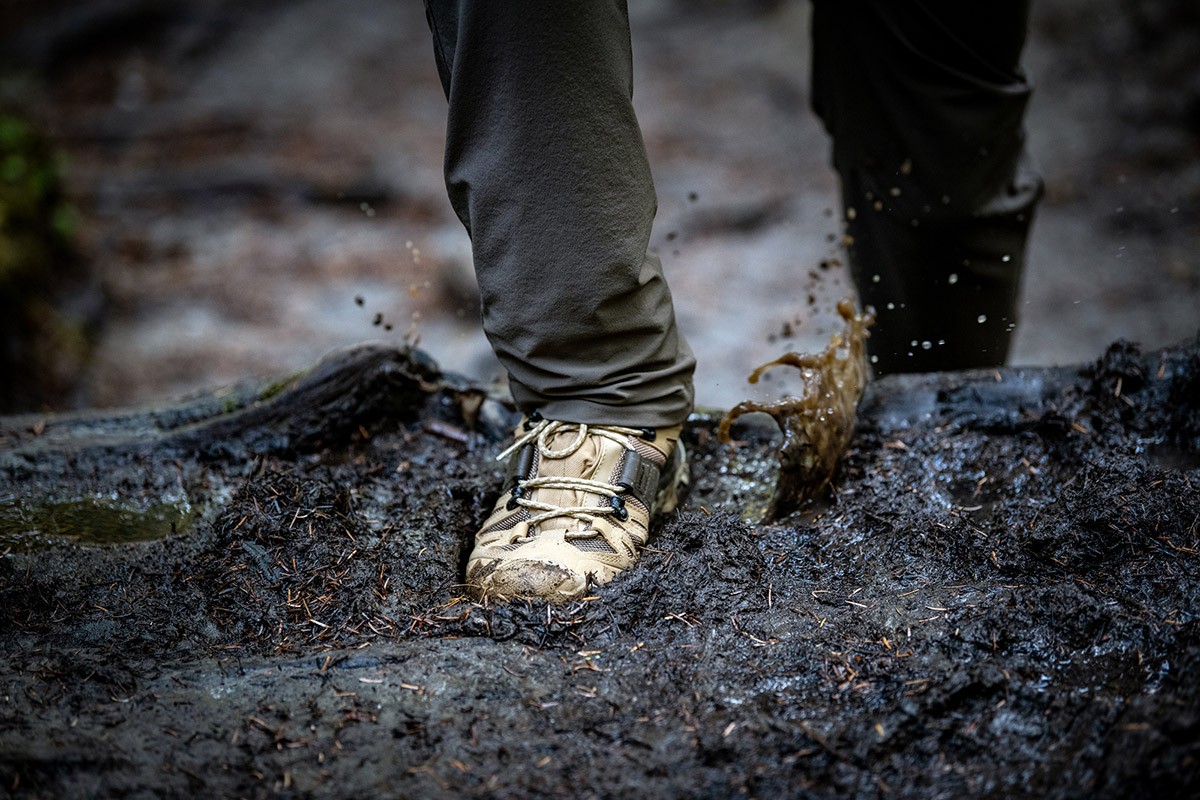 Waterproof hiking boots in mud
Waterproof hiking boots in mud
5. Drying Time: Which Boots Dry Faster?
Will non-waterproof or waterproof boots dry faster if they get wet unexpectedly? Non-waterproof shoes often use mesh or fabrics with larger pores, allowing air to flow through the materials more quickly, speeding up the drying process. Conversely, waterproof shoes have minimal airflow, causing water to remain in the fabric once it penetrates the liner. Waterproof shoes bogged down with moisture can feel heavy and lead to foot irritations and blisters. For consistent soaking like creek crossings, non-waterproof designs are preferable because they dry much faster if soaked through. Surprisingly, for trips with many water crossings, non-waterproof designs are often better.
 Waterproof shoes drying on porch
Waterproof shoes drying on porch
6. What’s the Difference Between Waterproof, Water-Resistant, and Water-Repellent?
What do waterproof, water-resistant, and water-repellent really mean when it comes to hiking boots? You’ll see these terms when shopping for hiking boots. Gore-Tex offers solid waterproofing, and many in-house waterproofing technologies are similar, although performance varies. Boots labeled as water-resistant resist light to moderate precipitation, but anything more will penetrate. Water-repellent footwear is surface-coated with a treatment like a DWR finish, repelling light moisture upon impact but wearing off over time. It can be revived to maximize longevity, so be sure to maintain your hiking boots for optimal performance and longevity.
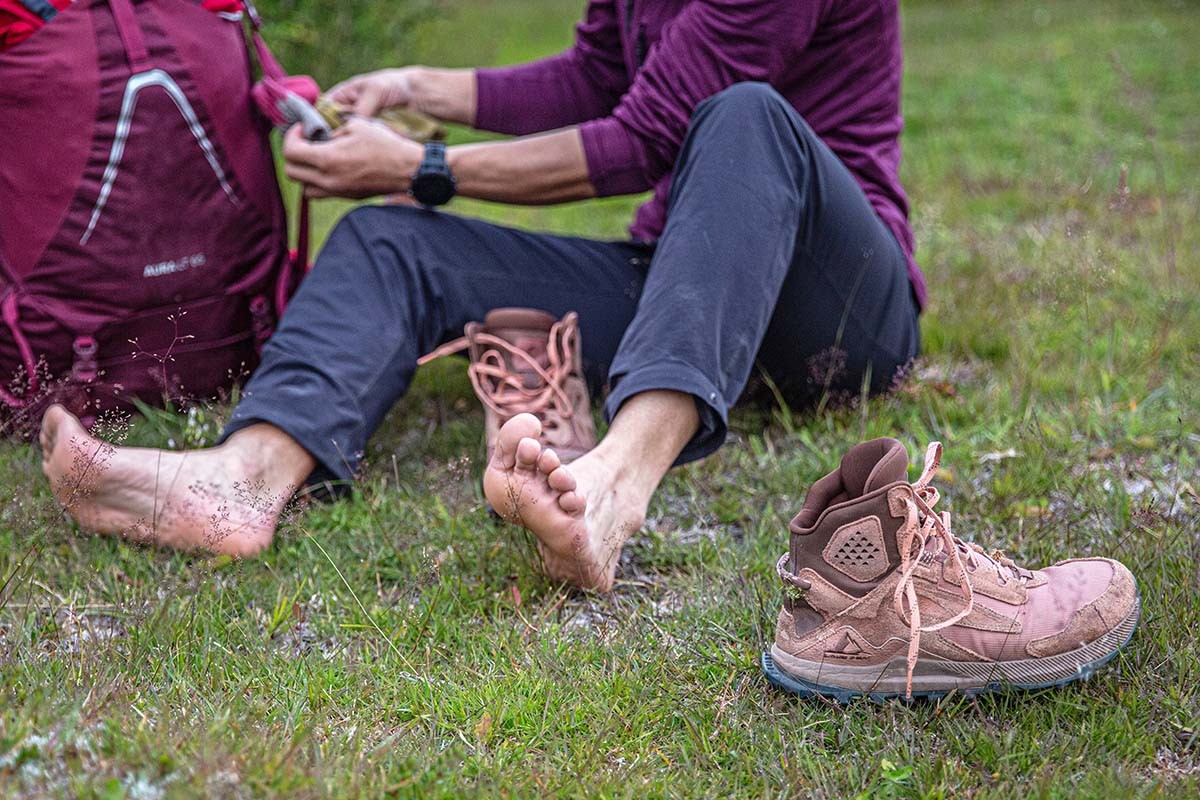 Taking off Non-waterproof boots
Taking off Non-waterproof boots
7. When Are Non-Waterproof Boots the Best Choice?
When should you choose non-waterproof footwear for your trip? There’s no need to spend extra money or carry extra weight with waterproof boots when hiking in hot, dry climates. When sweat is the biggest threat, opt for non-waterproof shoes for added breathability. For fast-and-light missions, the extra ounces from waterproof shoes can feel like pounds. In these cases, a non-waterproof shoe will cut weight and increase sweat evaporation. Also, avoid waterproof shoes on expeditions with deep, frequent river crossings. A quick-drying option is preferable over a thicker, lined boot that holds water longer, although water shoes or hiking sandals may be best.
 Hiking in Non-waterproof Hoka Speedgoat
Hiking in Non-waterproof Hoka Speedgoat
8. When Do Waterproof Boots Excel?
When is it ideal to wear waterproof boots? There’s a time and place for waterproof footwear: damp, cold weather or terrain that’s muddy or snowy. Think winter hikes, shallow stream crossings, and day trips in frequently wet climates. Bring waterproof hiking footwear to areas prone to daily rain showers or cooler places where you won’t sweat much. The ideal uses for waterproof hiking shoes fall mid-spectrum. While non-waterproof footwear excels in ultra-dry climates and is better for deep water crossings, waterproof shoes perform better in moderate rain and snow.
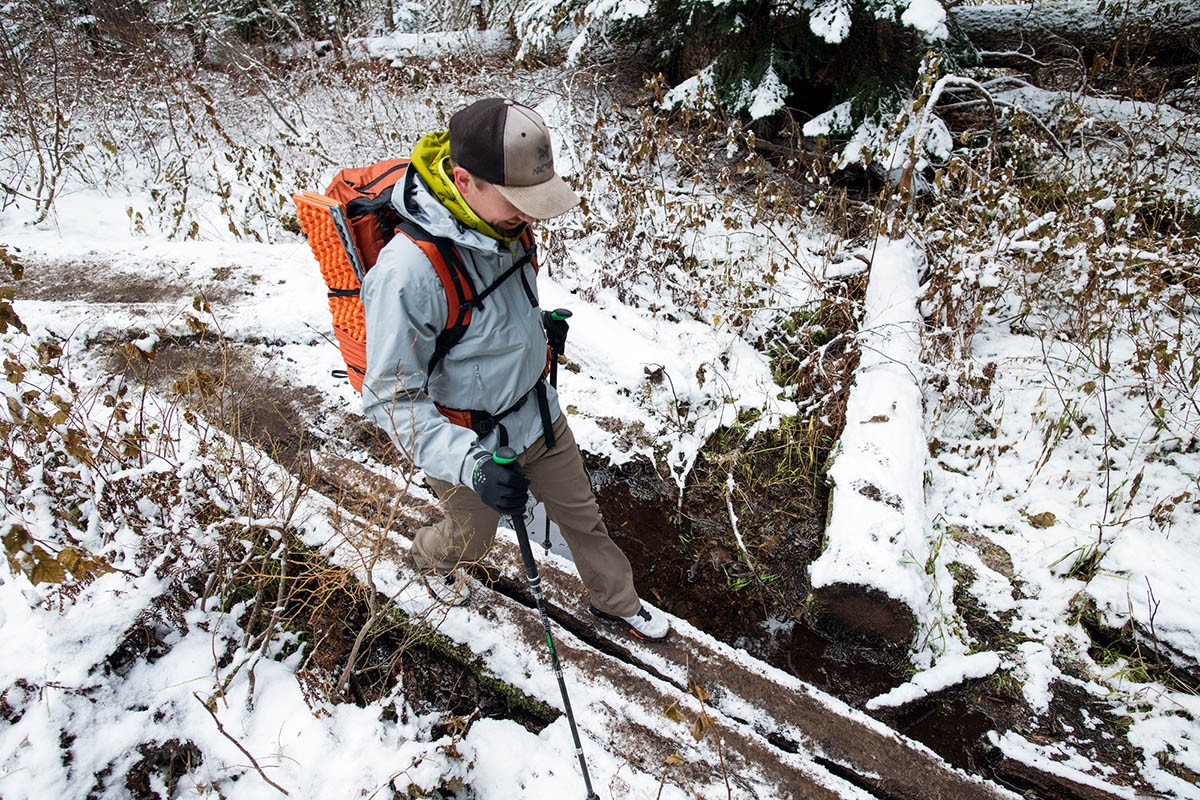 Wearing Salomon X Ultra 4 GTX on snowy trail
Wearing Salomon X Ultra 4 GTX on snowy trail
9. Making the Final Decision: Terrain and Climate
How should terrain and climate influence your choice of hiking boots? When deciding which hiking shoe or boot to purchase, terrain and climate are important. For extreme conditions like hot, dry deserts or extremely wet, river-ridden environments, consider non-waterproof footwear or multiple pairs of shoes. Some backpackers and thru-hikers use non-waterproof shoes with trail gaiters for added protection in inclement weather, which can be a nice compromise, although water will still enter at the sides of the shoe. Ultimately, the decision comes down to personal preference. Try on a few pairs, research your destination, and talk to gear shop experts who understand local conditions. Experiment to find what’s right for you. According to the Vietnam National Administration of Tourism, understanding the local climate and terrain is crucial for a successful and enjoyable trip.
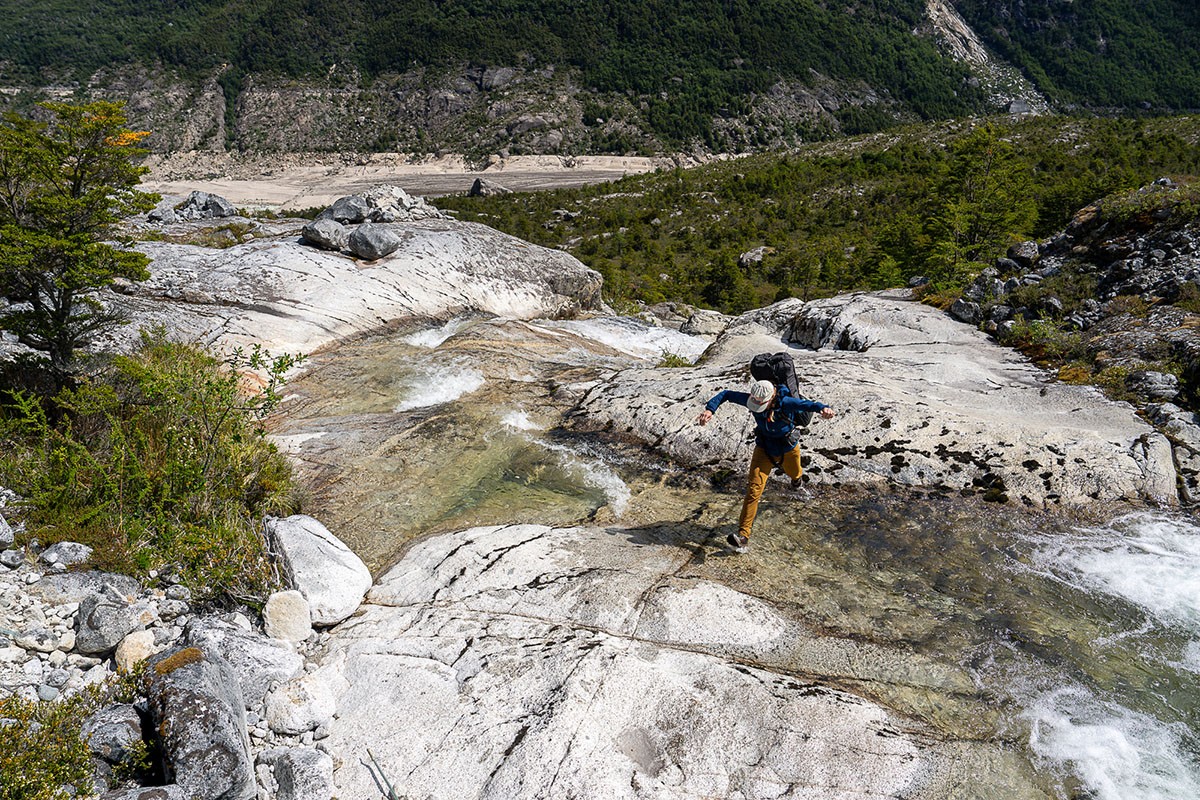 Crossing water with Waterproof boots
Crossing water with Waterproof boots
10. Navigating Vietnam’s Diverse Climates: A Region-by-Region Guide with SIXT.VN
What should travelers consider when choosing footwear for different regions in Vietnam? Vietnam boasts a diverse climate that varies significantly from north to south, influencing the type of footwear that is most suitable for each region. Understanding these regional differences will ensure you are well-prepared for your adventure.
10.1. Northern Vietnam: Sapa, Hanoi, and Ha Giang
Climate: Northern Vietnam experiences a distinct four-season climate. Winters (December to February) can be cold and dry, with temperatures occasionally dropping to near freezing, especially in mountainous areas like Sapa and Ha Giang. Summers (June to August) are hot and humid, with frequent rainfall. Spring (March to May) and autumn (September to November) offer more moderate temperatures and are generally considered the best times to visit.
Footwear Recommendations:
- Waterproof Boots: Essential for the wet and muddy conditions often encountered during the rainy season (May to October). They provide necessary protection against the elements, especially when trekking through rice terraces or hiking in mountainous regions.
- Breathable Non-Waterproof Shoes: Ideal for the drier months (November to April) when the trails are less likely to be waterlogged. They offer better ventilation, preventing your feet from overheating during long hikes.
- Hiking Socks: Pack both wool and synthetic socks to wick away moisture and keep your feet comfortable, regardless of the weather.
- Insider Tip: Consider bringing lightweight gaiters to keep mud and debris out of your shoes, especially during the rainy season.
10.2. Central Vietnam: Da Nang, Hoi An, and Hue
Climate: Central Vietnam has a tropical monsoon climate, with a distinct wet and dry season. The dry season lasts from January to August, with hot temperatures and high humidity. The wet season runs from September to December, bringing heavy rainfall and occasional typhoons.
Footwear Recommendations:
- Waterproof Boots: Necessary during the wet season to combat the frequent downpours and potential flooding. Look for boots that are also breathable to avoid excessive sweating.
- Water Sandals or Shoes: Perfect for exploring coastal areas and ancient towns like Hoi An, especially during the dry season. Choose options that offer good support and traction.
- Quick-Drying Shoes: Ideal for activities like canyoning or exploring waterfalls, where your feet are likely to get wet.
- Insider Tip: Check the weather forecast before you go, as Central Vietnam is prone to sudden and intense rainstorms.
10.3. Southern Vietnam: Ho Chi Minh City and Mekong Delta
Climate: Southern Vietnam has a tropical climate, with consistently warm temperatures year-round. The wet season lasts from May to November, characterized by heavy rainfall in the afternoons. The dry season, from December to April, is hot and humid with minimal rainfall.
Footwear Recommendations:
- Lightweight, Breathable Shoes: Essential for the hot and humid conditions. Look for shoes made of mesh or other ventilated materials.
- Water Sandals or Shoes: Ideal for exploring the Mekong Delta, where boat trips and walking through flooded areas are common.
- Waterproof Boots: Useful during the rainy season, especially if you plan on doing a lot of walking or hiking.
- Insider Tip: Invest in a good pair of moisture-wicking socks to keep your feet dry and comfortable in the humid climate.
10.4. Central Highlands: Da Lat and Pleiku
Climate: The Central Highlands enjoy a milder climate compared to other regions, with cooler temperatures and less humidity. The dry season is from November to April, and the wet season is from May to October.
Footwear Recommendations:
- Hiking Boots with Good Ankle Support: Essential for trekking in the mountainous terrain. Choose waterproof options for the wet season.
- Comfortable Walking Shoes: Suitable for exploring towns and coffee plantations.
- Warm Socks: Pack wool or synthetic socks to keep your feet warm in the cooler climate, especially during the evenings.
- Insider Tip: Be prepared for sudden changes in weather, especially if you are hiking at higher altitudes.
11. The Science of Comfort: Breathability and Foot Health
How do waterproof boots affect foot health, and what are the alternatives? The breathability of hiking boots is crucial for maintaining foot health, especially in varying climates like those found in Vietnam.
11.1. Importance of Breathability
- Sweat Management: According to a study published in the “Journal of Sports Science & Medicine,” the average foot can produce up to half a pint of sweat per day. Breathable footwear allows this moisture to evaporate, preventing the build-up of sweat that can lead to discomfort and blisters.
- Temperature Regulation: Breathable boots help regulate foot temperature, preventing overheating in warm conditions and maintaining warmth in cooler environments. This is particularly important in regions with fluctuating temperatures.
- Reduced Risk of Fungal Infections: Excessive moisture in footwear can create a breeding ground for bacteria and fungi, increasing the risk of conditions like athlete’s foot. Breathable materials help keep the feet dry, reducing this risk.
11.2. Downsides of Waterproof Boots
- Limited Airflow: Waterproof membranes like Gore-Tex, while effective at keeping water out, also restrict airflow. This can lead to sweat accumulation inside the boot, making feet feel damp and uncomfortable.
- Increased Risk of Blisters: The combination of moisture and friction inside waterproof boots can significantly increase the risk of blisters, especially during long hikes.
- Overheating: In hot and humid climates, waterproof boots can cause feet to overheat, leading to discomfort and reduced performance.
11.3. Alternatives and Solutions
- Non-Waterproof Boots with Gaiters: This combination offers a balance between breathability and protection. Non-waterproof boots allow for better ventilation, while gaiters can be added to keep out water and debris in wet conditions.
- Moisture-Wicking Socks: Socks made from materials like merino wool or synthetic fibers can help wick away sweat, keeping feet dry and comfortable.
- Foot Powders and Antiperspirants: These products can help reduce sweat production and keep feet dry inside boots.
- Proper Boot Fit: Ensuring a proper fit is crucial for comfort and foot health. Boots that are too tight can restrict airflow and increase friction, while boots that are too loose can lead to blisters.
- Regularly Change Socks: Changing socks during long hikes can help keep feet dry and prevent the build-up of moisture.
11.4. Expert Insights
Dr. Emily Carter, a podiatrist specializing in sports medicine, advises: “When choosing hiking boots, prioritize breathability, especially if you’re hiking in warm or humid conditions. Look for boots with mesh panels or ventilation features, and always wear moisture-wicking socks. If you opt for waterproof boots, be extra diligent about managing moisture to prevent blisters and fungal infections.”
12. Making the Right Choice for Your Vietnam Adventure: A Comprehensive Checklist
To make an informed decision about whether to bring waterproof boots to Vietnam, consider the following checklist:
12.1. Checklist Items
- Destination:
- List all the regions in Vietnam you plan to visit.
- Research the typical climate and weather conditions for each region during your travel dates.
- Activities:
- List the activities you plan to engage in (e.g., trekking, city tours, beach visits).
- Consider the potential for wet conditions during each activity.
- Weather Forecast:
- Check the weather forecast for your specific travel dates and destinations.
- Be prepared for sudden changes in weather, especially during the rainy season.
- Footwear Needs:
- Determine whether you need waterproof, water-resistant, or breathable shoes based on the above factors.
- Consider bringing multiple pairs of shoes to accommodate different conditions.
- Budget:
- Factor in the cost of waterproof boots, which are generally more expensive than non-waterproof options.
- Weigh the cost against the potential benefits for your specific trip.
- Weight:
- Consider the added weight of waterproof boots, especially if you plan to do a lot of walking or hiking.
- If weight is a concern, opt for lightweight, breathable options.
13. Top Hiking Footwear Picks
What are some of the best waterproof and non-waterproof hiking shoes available?
13.1. Waterproof
- Best overall: Salomon X Ultra 4 Mid GTX men’s / X Ultra 4 Mid GTX women’s
- Best budget: Merrell Moab 3 Mid WP men’s / Moab 3 Mid WP women’s
- Best for backpacking: Salomon Quest 4 GTX men’s / Quest 4 GTX women’s
- Best max-cushioned boot: Hoka Anacapa 2 Mid GTX men’s / Anacapa 2 Mid GTX women’s
- For fast-and-light mountain adventures: La Sportiva Ultra Raptor men’s / Ultra Raptor women’s
13.2. Non-Waterproof
- Best overall: Salomon X Ultra 4 men’s / X Ultra 4 women’s
- Best budget hiking shoe: Merrell Moab 3 men’s / Moab 3 women’s
- Best ultralight and cushioned hiking shoe: Hoka Speedgoat 5 men’s / Speedgoat 5 women’s
- Best for off-trail scrambling: La Sportiva TX4 Evo men’s / TX4 Evo women’s
- Best non-waterproof boot: Hoka Anacapa Breeze Mid men’s / Anacapa Breeze Mid women’s
14. SIXT.VN: Your Premier Travel Partner in Vietnam
How can SIXT.VN enhance your travel experience in Vietnam? At SIXT.VN, we’re dedicated to making your trip to Vietnam as smooth and enjoyable as possible. We understand the challenges travelers face when planning a trip, and we’re here to offer comprehensive solutions tailored to your needs.
14.1. Overcoming Travel Challenges in Vietnam
- Detailed Planning: Planning a detailed trip to Vietnam can be overwhelming due to the diverse climates, numerous attractions, and logistical considerations.
- Language and Cultural Barriers: Navigating Vietnam can be difficult due to language differences and cultural nuances.
- Finding Reliable Services: It can be challenging to find trustworthy and high-quality travel services.
- Transportation Difficulties: Getting around in Vietnam can be confusing and time-consuming without proper guidance.
14.2. How SIXT.VN Helps
- Personalized Travel Itineraries: SIXT.VN offers customized travel itineraries based on your interests, preferences, and travel duration. Whether you want to explore the bustling streets of Hanoi, trek through the rice terraces of Sapa, or relax on the beaches of Phu Quoc, we can create a perfect plan for you.
- Airport Transfer Services: We provide reliable and comfortable airport transfer services to ensure a smooth arrival and departure experience. Our professional drivers will greet you at the airport and transport you to your hotel safely and efficiently.
- Hotel Booking Assistance: SIXT.VN helps you find the best accommodations that suit your budget and preferences. We partner with a wide range of hotels, from budget-friendly options to luxury resorts, ensuring you have a comfortable and enjoyable stay.
- Tour and Excursion Bookings: We offer a variety of tours and excursions to help you explore the best of Vietnam. Whether you want to visit historical sites, explore natural wonders, or experience local culture, we have something for everyone.
- Flight Booking Services: SIXT.VN assists you in finding the best flight deals and schedules to make your travel arrangements hassle-free. We work with major airlines to offer you a wide range of options to suit your needs.
- Professional Tour Guides: Our experienced and knowledgeable tour guides can provide valuable insights into the history, culture, and traditions of Vietnam, making your travel experience more enriching.
14.3. Benefits of Choosing SIXT.VN
- Convenience: We offer a one-stop solution for all your travel needs, saving you time and effort in planning your trip.
- Reliability: We partner with trusted service providers to ensure you receive high-quality and reliable services.
- Expert Support: Our dedicated team of travel experts is available to assist you with any questions or concerns you may have, ensuring a smooth and stress-free travel experience.
- Customization: We tailor our services to meet your specific needs and preferences, ensuring a personalized travel experience.
15. Call to Action
Ready to embark on an unforgettable journey through Vietnam? Let SIXT.VN be your trusted travel partner. We offer a range of services to make your trip seamless and enjoyable, from personalized itineraries to airport transfers and hotel bookings.
15.1. Contact Us
- Address: 260 Cau Giay, Hanoi, Vietnam
- Hotline/Whatsapp: +84 986 244 358
- Website: SIXT.VN
15.2. Explore Our Services
- Tailored Itineraries: Discover Vietnam your way with our custom-designed travel plans.
- Airport Transfers: Start and end your trip with ease with our reliable airport pickup and drop-off services.
- Hotel Bookings: Choose from a wide selection of accommodations to fit your style and budget.
- Tours and Excursions: Immerse yourself in the culture and beauty of Vietnam with our guided tours.
- Flight Arrangements: Get the best deals on flights to Vietnam with our expert booking assistance.
15.3. Book Your Adventure Today
Visit SIXT.VN and start planning your dream trip to Vietnam. Our expert team is ready to assist you every step of the way.
16. Frequently Asked Questions (FAQ)
16.1. Is it better to have waterproof boots for hiking in Vietnam?
The need for waterproof boots depends on the region and time of year. They’re useful in Northern Vietnam during the rainy season and in Central Vietnam for wet conditions.
16.2. What are the benefits of waterproof hiking boots?
Waterproof boots keep your feet dry in wet conditions, providing comfort and protection against the elements.
16.3. What are the drawbacks of waterproof hiking boots?
They can be less breathable, causing sweat buildup, and may take longer to dry if water gets inside.
16.4. When should I choose non-waterproof hiking boots?
Opt for non-waterproof boots in hot, dry climates where breathability is more important than waterproofing.
16.5. How do I maintain my waterproof hiking boots?
Clean them regularly to remove dirt and grime, and reapply DWR coatings to maintain water repellency.
16.6. What is the difference between waterproof, water-resistant, and water-repellent?
Waterproof offers the highest level of protection, water-resistant provides moderate protection, and water-repellent offers minimal protection.
16.7. Can I use gaiters with non-waterproof boots for added protection?
Yes, gaiters can provide extra protection against water and debris, making non-waterproof boots more versatile.
16.8. What type of socks should I wear with hiking boots?
Wear moisture-wicking socks made of wool or synthetic materials to keep your feet dry and comfortable.
16.9. Are waterproof boots necessary for city tours in Vietnam?
Not usually. Lightweight, breathable shoes are generally more comfortable for walking around cities.
16.10. How do I choose the right hiking boots for my trip to Vietnam?
Consider the climate, terrain, and activities you plan to engage in, and try on a few pairs to find the best fit and comfort.



